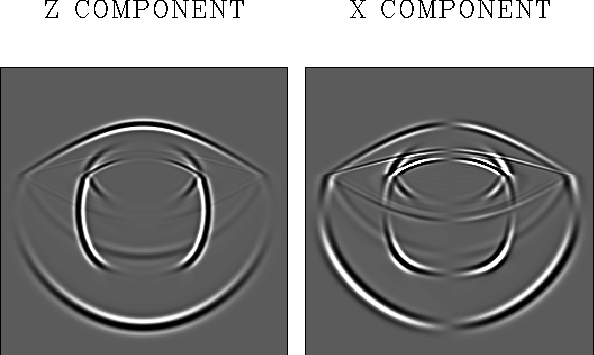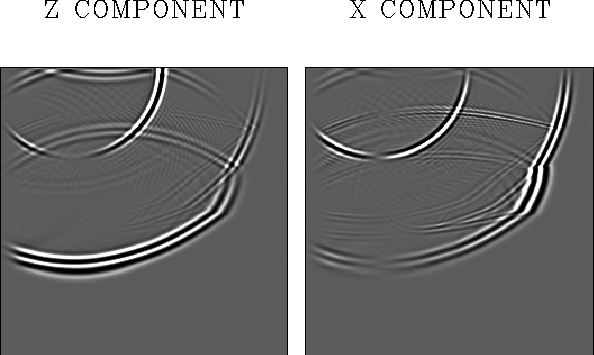




Next: CONCLUSIONS
Up: Cunha: Accurate Elastic Modeling
Previous: The temporal and spatial
In this section I show two examples that illustrate the method.
The first one represents a vertically polarized displacement source
in a two-layer medium (Figure ![[*]](http://sepwww.stanford.edu/latex2html/cross_ref_motif.gif) ). The top medium is
isotropic and the bottom medium (where the source is located)
is transverse-isotropic. Both the vertical and horizontal components of
the displacement field are displayed.
elastic1
). The top medium is
isotropic and the bottom medium (where the source is located)
is transverse-isotropic. Both the vertical and horizontal components of
the displacement field are displayed.
elastic1
Figure 5 The source is a vertically-polarized displacement field located
in the bottom layer of a two-layer model. The upper layer is isotropic,
while the bottom is transverse isotropic.
The left and right panels represent, respectively, the vertical
and the horizontal components of the displacement field. Press the button
to see a movie.





The second example (Figure ![[*]](http://sepwww.stanford.edu/latex2html/cross_ref_motif.gif) ) has an explosive source
located below a free-surface boundary. The media has some degree of
structural complexity and the side and bottom boundaries are
absorbing, with the absorbing region visible in the figure.
) has an explosive source
located below a free-surface boundary. The media has some degree of
structural complexity and the side and bottom boundaries are
absorbing, with the absorbing region visible in the figure.
elastic2
Figure 6 The source is a spherically symmetric explosive field located
near the free surface of a structurally complex model. The two panels follow
the same convention as Figure (![[*]](http://sepwww.stanford.edu/latex2html/cross_ref_motif.gif) ). Press the button
to see a movie.
). Press the button
to see a movie.










Next: CONCLUSIONS
Up: Cunha: Accurate Elastic Modeling
Previous: The temporal and spatial
Stanford Exploration Project
12/18/1997

![[*]](http://sepwww.stanford.edu/latex2html/cross_ref_motif.gif) ). The top medium is
isotropic and the bottom medium (where the source is located)
is transverse-isotropic. Both the vertical and horizontal components of
the displacement field are displayed.
). The top medium is
isotropic and the bottom medium (where the source is located)
is transverse-isotropic. Both the vertical and horizontal components of
the displacement field are displayed.
